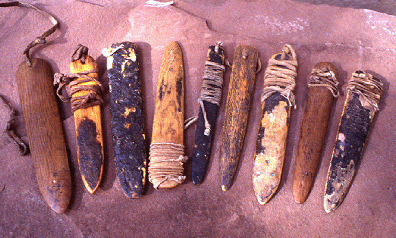|
digital image by Two Horses Running
Known as the 'voice of God' to the Australian Aborigines
and given to the males of the Clan at naming ceremonies or other auspicious occasions. Used as a 'talk back switch' to the
Creator. To sound a Bullroarer it is swung lasso style which causes it to spin and make a 'humming type' sound. It is called
by several different names including 'Burliwarni','Ngurrarngay',and 'Muypak'. They were used to display sacred symbols and
sounded to warn the uninitiated that they were being shown. They were also used to send animals into ambush, and to alert
one tribe of anothers presence, and in rainmaking ceremonies.
This type of instrument has been used all over the world.
To the Maori it is called 'Purerehua'(butterfly), and it was used by North American Native Cultures from the Athabaskan, Nootka,
Yokuts, Pomo, Hopi, Aztec and more. The Navajo call it the 'groaning stick' (tsin di'ni) and use it to drive away
evil or drive out illness. Made from pine wood that has been struck by lightning, covered with yucca pitch, and attached to
a cord made from bighorn or buckskin. During Navajo sacred ceremonies, the medicine man uses the bullroarer to slice through
the air, creating an opening that allows the Yei B'Chei (diety) to enter the physical world. In New Guinea it
was placed inside humanlike effigies in the throat area symbolizing the spirit voice of the effigy and was sometimes used
in ceremony.
* The sound that the Bullroarer makes is sacred
to the Apaches, within their culture it is not to be displayed or whirled outside of sacred circles.
| NAVAJO BULLROARERS |

|
| photograph by Mitch Nur |
copyright 2007 by 9ways
|